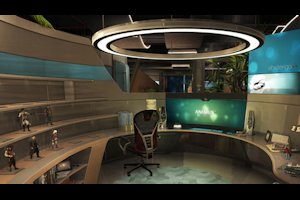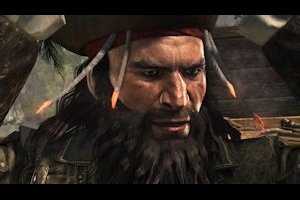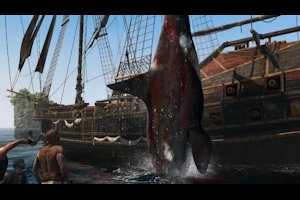Assassin's Creed IV: Black Flag
One year after the release of Assassin's Creed III, Ubisoft released its follow-up, Assassin's Creed IV: Black Flag. Despite my enthusiasm for the series, I had a hard time mustering up the energy for a new entry so quick on the heels of the last one. After all, some of my biggest complaints about Assassin's Creed III involve its short gestation period and high glitch count. But now that I've finally gotten around to playing the more pirate-centered Black Flag, was I right to be weary of the franchise, or do I regret my hesitation?
STORY
 | | They provide awesome cubicles over at Abstergo Entertainment |
In the present day, you start the game as a new, unnamed protagonist who is showing up for his first day of work at Abstergo Entertainment, a video game company that uses Animus technology to provide cloud-based experiences based on historical events. You are assigned to "Sample 16," a DNA strand that contains the genetic memory of a notable pirate named Edward Kenway (Connor's grandfather), and instructed to go through these memories to help design an interactive high seas adventure that focuses on notable historical figures such as Edward "Blackbeard" Thatch. However, it isn't long before you are thrown into a familiar conpiracy involving a mysterious historical artifact, Templars, Assassins, and what happened to the source of the Sample 16 DNA: Desmond Miles.
In the early Eighteenth Century, you are a pirate whose sole motivation--at least in the beginning--is the search for wealth. There is an enormous cast of unsavory characters, and it isn't long before Kenway dons the appearance of both an Assassin and a Templar in order to uncover the truth behind "the Sage." Throughout history, the Sage has been many different people, but all of them are nearly identical and they all struggle with a second set of memories that draws them to a secret "Observatory" somewhere in the same West Indies waters where Kenway sets sail. With both the Templars and the Assassins hot on the trail of the Sage and his Observatory, Kenway becomes convinced that untold riches await there.
While the so-called Golden Age of Piracy isn't quite as rich or recognizable as the American Revolution, the Italian Renaissance, or the Crusades, the writers make the most of this time period, proving that it's a natural fit for the seemingly endless struggle between those who seek to control the world behind the scenes and those who seek to keep men free from such bonds. Edward Kenway, though not the most noble hero in Desmond's bloodline, is far more likeable than Connor or Altaïr, and his character goes through a strong arc that may not seem obvious until late in the story, leading to a surprisingly poignant conclusion.
 | | Blackbeard owns this game |
On the downside, Edward's tale is stuffed with far too many characters, including several who look and act nearly identical to one another. It also falls into the trap of other pirate stories in that practically every character goes through at least one change of heart, leading to betrayal and repetitive plot twists. While not reaching the absurd levels of Pirates of the Caribbean: At World's End, the story still gives you little reason to care about more than two or three characters. The villains, too, are fairly one-note and predictable, a common problem throughout the series that is not solved here.
Where the plot really shines is in the present day, throwing you into a trippy meta-reality in which Abstergo Entertainment is trying to create a game every year. It takes a while before you learn what's going on, but when you do, you're in for some pretty cool surprises. Without spoiling too much, I will say that meeting the coffee guy blew my mind. My only complaint about this storyline is that it is so short in comparison to the main game, especially after Assassin's Creed III spent so much time in the present day.
|
[Story: 9 - It's not on the same impressive level as the previous installment, but it still provides plenty of heart and mind-bending paranoia to keep fans happy.]
|
|
GAMEPLAY
 | | I'm better than you, Shamu |
Each game in the series builds upon the tools introduced in the previous one, and Assassin's Creed IV: Black Flag is no exception. This installment learns from one of its predecessor's primary mistakes--the ludicrously long tutorial--by throwing you into Kenway's world without over-explaining what you're supposed to do. At first, you are confined to a small island and then a small city, and you can be forgiven for not seeing anything that makes this particular game special. You have many of the same tools previous Assassins have had, like blending in with small crowds, using eagle vision, diving into haystacks, synchronizing viewpoints, hunting small animals, hiring dancers to distract guards, hiding bodies in bushes, and more, and for people (like me) who go into this game weary of the old formula will probably find this part to be the most tedious. However, while there are an enormous number of activities to distract you from the main mission, it has also been deceptively streamlined to do away with many of the more cumbersome parts of previous games.
The game takes off in earnest once you set sail. It is at this point that the game snaps into place, when it becomes obvious why the developers didn't spend much time creating new things for Kenway to do on land. Assassin's Creed III dabbled in high seas adventure--and did it well--but Black Flag dives so deep into the various mechanics of life at sea that, in many ways, this feels more like an amazing piracy simulator than an Assassin's Creed game. You collect your shanty-singing crew, gather materials by fighting and boarding enemy vessels, seige forts, explore tiny islands, dive underwater to raid chests while avoiding sharks and jellyfish, harpoon whales and sharks, follow hand-drawn maps to buried treasures, and much more. There is so much to do and it is so well executed that the main mission will quickly become an afterthought.
One could compare the piracy aspects of the game to a grown-up version of The Legend of Zelda: Windwaker or Sid Meier's Pirates, but one that handles everything in a much more balanced way. While the map is enormous by almost any standard, sailing from place to place is never boring. The controls are also fluid and intuitive, and it can be fun listening to your crew react to button presses with shouted orders and scrambling at the ropes. Combat, too, can be highly entertaining, especially if you put in the time to outfit your rig with the best armor and weaponry you can.
-e. magill 3/4/2014
|
|